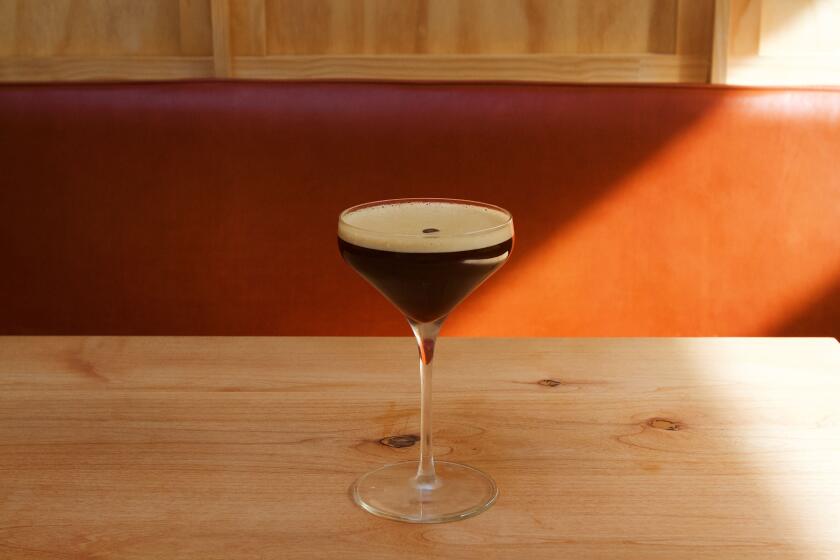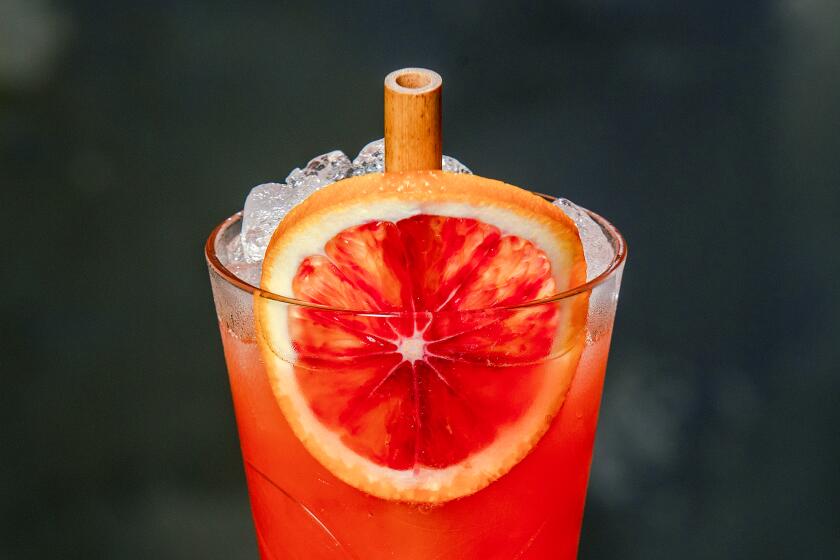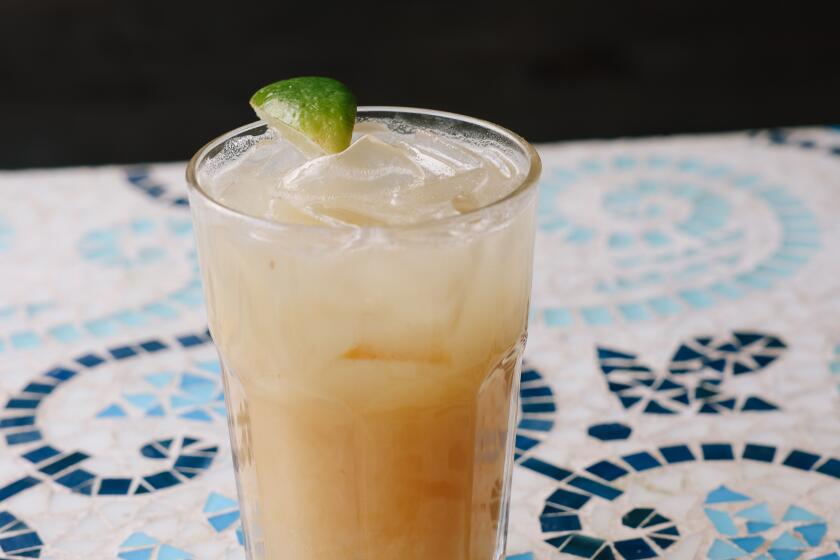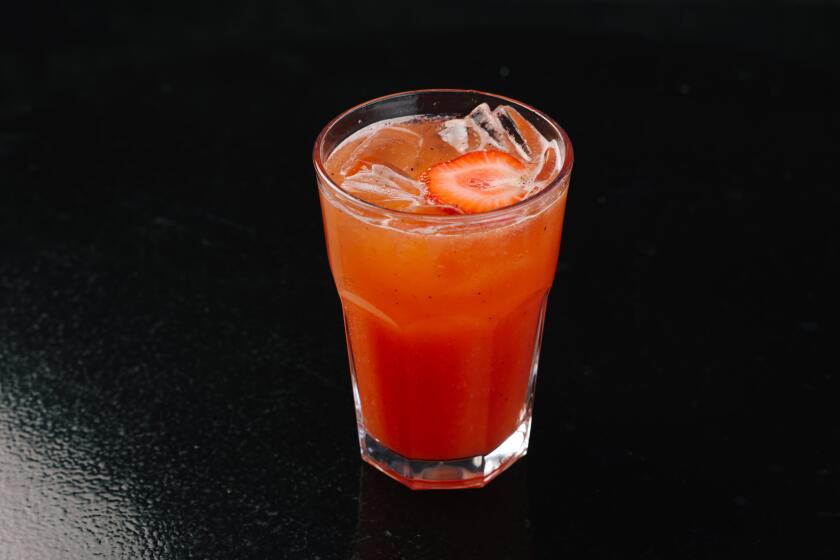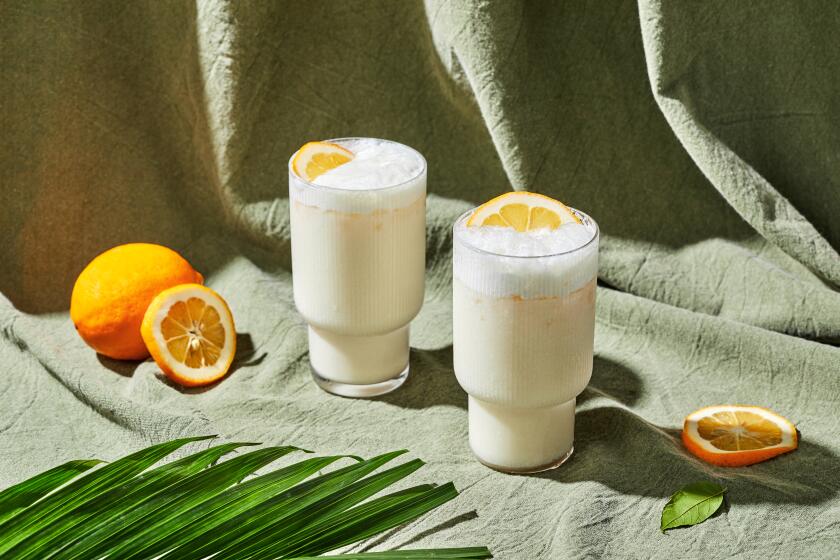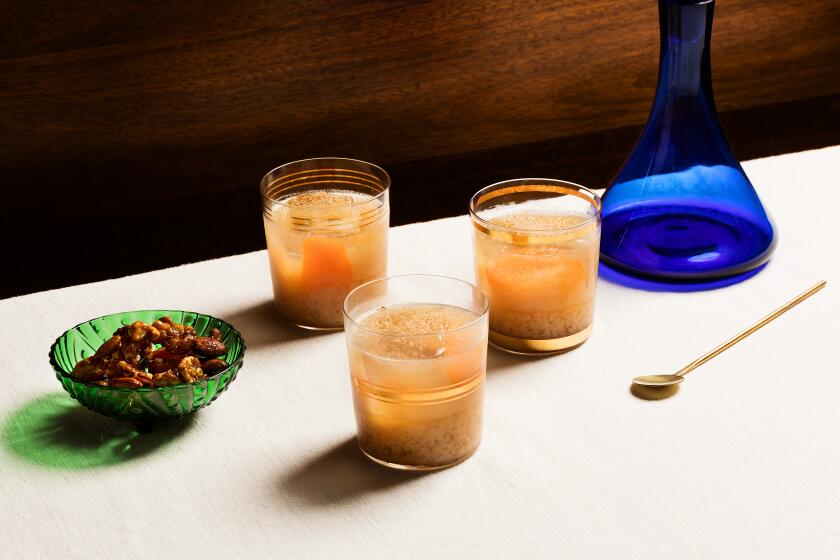Prom Dress
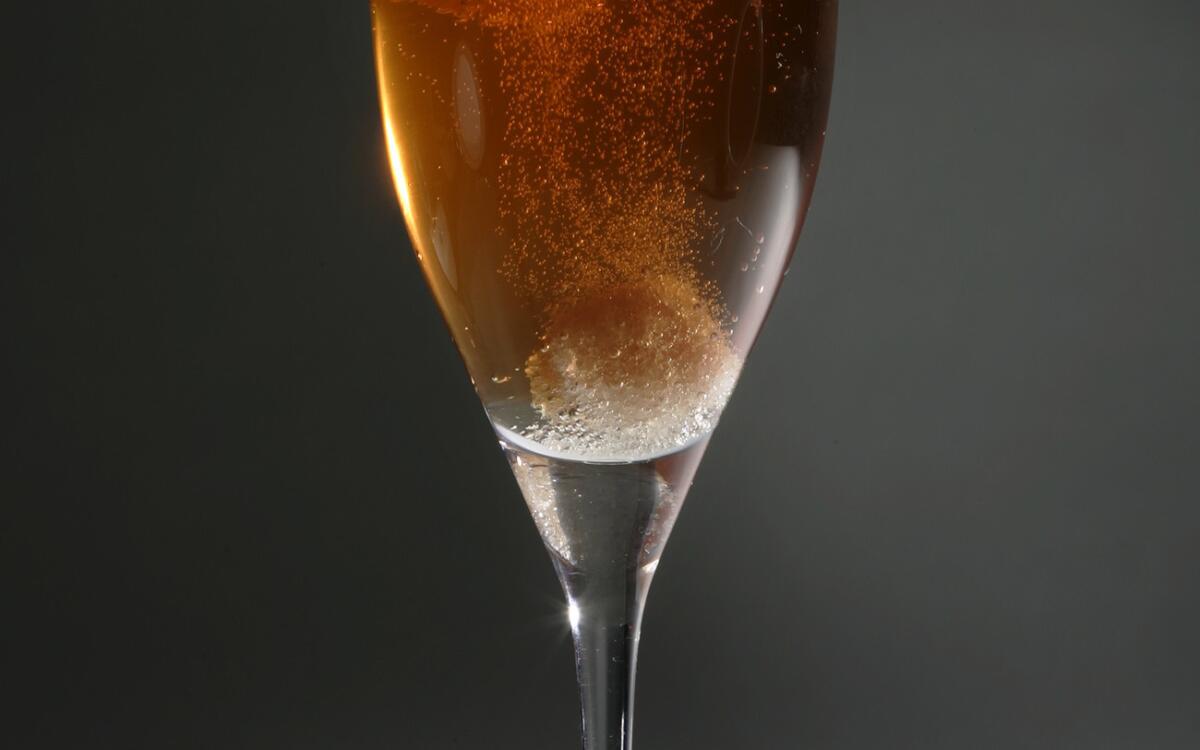
Lately, one Angeleno has been telling bartenders to keep adding bitters to her Champagne cocktail âuntil itâs the color of my prom dress.â Thatâs way more than a dash or two -- it takes about a teaspoon of Angostura to turn Champagne pink.
She positively likes bitters. How about that? Not too long ago, bitters seemed just a weird leftover from the golden age of 19th century quack medicines -- an evil-tasting liquid that came in tiny bottles with wordy, antique labels. It may have been traditional in certain cocktails, but many people had taken to leaving it out.
Today, though, these bitter extracts of roots, barks and other botanical ingredients seem to be making a comeback. Just a few years ago, liquor stores usually carried only one brand of bitters, Angostura, but now you can easily find five or six, with radically different flavors, including orange, peach and mint.
The fact is, you can get tired of all the simple-minded cocktails being invented in this flavored-vodka-plus-fruit-juice age. Bitters clean up after too much sweetness.
Still, the taste for bitterness might seem surprising. We all think bitterness is unpleasant -- but is it? Children certainly donât like it, but as grown-ups we learn to love coffee and chocolate. In fact, these days weâre actually going for more bitterness -- espresso, ever darker and more bitter chocolate.
âFrom a taste standpoint,â says Peter Birmingham, bartender-sommelier at Normanâs in West Hollywood, âa bitters makes the mouth water and promotes visual and smell pleasures, because it contains concentrated flavor essences. The bitterness itself makes the flavors [of a drink] extend. Here at Normanâs, we hang our hat on a Manhattan made with Peychaud bitters, sweet vermouth and Joshua Brook bourbon.â
The Manhattan is a classic cocktail because it harmoniously amplifies the rugged, woody flavor of whiskey with the fruity sweetness of vermouth and the perfume and bracing astringency of bitters. Birminghamâs particular version relies on the exotic flavor of Peychaud.
âMost bars donât even bother using Angostura bitters in their Manhattans anymore, which is a real shame,â says Jeremiah Doherty of Grace in Los Angeles. âTry the two side by side and youâll be able to tell the difference, I promise.â
âAnother thing,â says Birmingham. âMost bitters have a modest alcohol profile, so they give you a lift without mowing you down. Theyâre particularly useful in non-alcoholic cocktails.â For pregnant women and others who want a very low alcohol drink, Birmingham makes a virgin mojito with a couple of splashes of mint bitters. âItâs like mint-flavored limeade with a little something extra,â he says.
Bitters were originally medicines. If you tell a bartender you have an upset stomach, heâll probably give you a glass of soda and bitters -- and it will probably work. A lot of people trust bitters to see them through the early stages of a hangover. Certain bitters started out as malaria treatments, because they contained quinine, just as tonic water does.
Still others once claimed to cure absolutely anything that ailed you. Many of the worthless patent medicines so popular in the late 19th century billed themselves as bitters. One secret of their popularity was the fact that they were extracted from all their secret roots and herbs with alcohol. They were a respectable way of getting a shot of booze.
So itâs not surprising that medicinal bitters ended up in mixed drinks, particularly when their beneficial effect on flavor was recognized. Until the late 1880s, every drink called a cocktail contained bitters.
Thereâs a distinction to be made between aromatic bitters -- the kind that come in tiny bottles and are used in small quantities as a flavoring -- and bitter liqueurs. The latter can be, and often are, drunk by themselves, because theyâre sweet enough to be palatable. Downing a shot of Jager is one thing, but even the biggest bitters fan in the world probably wouldnât drink a whole glass of Angostura.
The best-known aromatic bitters is Angostura with its spicy, clove-like aroma. âAngostura is versatile,â says Birmingham. âIt has a wide range of applications. But like Worcestershire sauce, it has only one note.â
Peychaudâs bitters has an anise and aromatic root scent, which makes it particularly suitable to cocktails with an anisette component, such as the famous Sazerac. Both Angostura and Peychaudâs get their bitterness from gentian root, which adds its own dry, sardonic aroma.
Orange peel is bitter as well as fragrant, and there were several brands of orange bitters on the market through the 1950s before they died out. The style has recently been revived. Fee Bros. is the most widely available brand, found in many larger liquor stores (Feeâs also makes three other bitters; see the box on Page 9). The Stirrings company of Nantucket, whose mixers are carried by Sur La Table, has just introduced a bitters made from blood oranges. Author-bartender Gary Regan makes Reganâs Orange Bitters, which has a more aggressive flavor than the others, fuller, spicier and more bitter.
In the 19th century, orange bitters was the choice for gin or vermouth cocktails, while Angostura tended to go with whiskey or Champagne. A new generation of mixologists may or may not follow that tradition.
By comparison with this short list of aromatic bitters, there are literally scores of bitter liqueurs, ranging from mildly bitter vermouth and the familiar liqueurs Dubonnet and Campari to rarities such as Jeppson Malort and Zwack Unicum. Nearly every country in Europe has its own traditional bitter liqueurs. They all have their uses.
Graceâs Doherty has created two cocktails that capitalize on bitters. The Luca Brasi is his version of the Americano -- Charbay blood orange vodka, Punt e Mes (a bittered vermouth) and soda. His latest is the Marco Polo: Bombay gin, ginger juice, Campari and soda.
âI started this one with just gin and the ginger juice but felt it was too sweet,â says Doherty. âSo I added Campari, and the drink changed completely. The bitter was just the thing to cut the sweetness, bring out the flavors of the gin and tame the fire of the ginger.â
Some cocktails, such as sours and highballs, arenât improved by a bitter flavoring, the latter because theyâre intentionally light and simple, the former because -- the virgin mojito notwithstanding -- sourness and bitterness rarely go well together. In others, though, people instinctively add a bitter flavor, whether or not they actually reach for a bitters bottle.
Take the martini. Originally it consisted of gin, vermouth and orange bitters, but the bitters dropped out of the formula early in the 20th century. What saved the martini from blandness (especially as people started using less and less vermouth) was a bitter garnish, either an olive or a twist of lemon peel. And eventually we got the dirty martini, flavored with olive brine -- which is, in effect, a salty bitters for a post-margarita generation.
If aromatic bitters are basically a flavoring, why not use them in food? People do.
The label of the Angostura bottle has always suggested adding a dash to stews, sauces and salad dressings. Six years ago, Trinidad food writer Wendy Rahamut published a cookbook (âThe Taste That Changed the Worldâ) in which she threw Angostura into just about anything you can imagine -- coleslaw, pea soup, pot roast, lasagna -- producing a pleasant, mysterious effect, like the indefinable sparkle a dish gets from a dash of Worcestershire.
Some people even put a little on their vanilla ice cream. Once you start down the bitters trail, you can feel like slapping every simple-minded sweet taste on Earth with a jolt of grown-up complexity and sophistication.
Aromatic bitters
Angostura. Developed in Venezuela by a German doctor, itâs the long-standing favorite; sweet spice (mostly clove) aroma with a winy character.
Fee Bros. Based in Rochester, N.Y., this company makes several rather mild bitters including Old Fashion Bitters, clove and citrus note but not much bitterness; Orange Bitters, like a spiced triple sec with bitter orange peel; Mint Bitters, peppermint with an edge; Peach Bitters, aroma of peaches and bitter almonds.
Peychaudâs. Made by the Sazerac Co. of New Orleans with a complex aroma suggesting anise with a hint of root beer.
Reganâs. Gary Regan, author of âThe Joy of Mixology,â makes a spicy, peppery Orange Bitters, aggressively flavored with gentian and quinine. At www.buffalotrace.com.
Agwa. A Bolivian liqueur with an attractive bitterness and a slight stimulative effect -- contains ginseng, guarana and (nonnarcotic) coca leaf.
Amaro Felsina Ramazzotti. A vermouth with bitter orange flavors.
Campari. A bitter vermouth with a cherry-like aroma.
Cynar. A sweet vermouth bittered with artichoke.
Dubonnet. A vermouth flavored with quinine, herbs and spices.
Fernet Branca. Numerous herbs, including peppermint; from a Milan producer.
Jagermeister. Complex herbal flavor; from Germany.
Punt e Mes. A bitter vermouth.
Suze. The French aperitif; flavors of gentian, orange and vanilla.
Torani Amer. A sweet vermouth with orange, gentian and quinine flavors, somewhat reminiscent of Amer Picon, a traditional Basque vermouth not available in this country.
Put a few drops of bitters onto the sugar cube and place it in a Champagne flute. Add the sparkling wine and the rest of the bitters and garnish with lemon peel.
Get our Cooking newsletter.
Your roundup of inspiring recipes and kitchen tricks.
You may occasionally receive promotional content from the Los Angeles Times.










